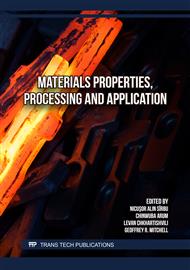[1]
D. Chiguvi (2022). The impact of urbanization on housing shortages in Gaborone, Botswana. International Journal of Research in Business and Social Science (2147-4478), 11(10), 423-429.
DOI: 10.20525/ijrbs.v11i10.2115
Google Scholar
[2]
S. Chainey, C. Shijagurumayum, & S. Thokchom (2022). Review on the use of bamboo as a construction material. Samriddhi a Journal of Physical Sciences Engineering and Technology, 14(01 SPL), 47-51.
DOI: 10.18090/samriddhi.v14spli01.9
Google Scholar
[3]
A. E. Tohlob (2024). The Impact of Population Growth on Construction Material Prices in Egypt: Exploring Sandbags as a Viable Alternative. ERJ. Engineering Research Journal, 47(2), 217-229.
DOI: 10.21608/erjm.2024.248887.1306
Google Scholar
[4]
Adebola, J., Ikumapayi, C. and Arum, C. (2023) Effectiveness of Rice Husk and Sugarcane Bagasse Ashes Blended Cement in Improving Properties of Concrete. Journal of Materials Science and Chemical Engineering, 11, 1-19.
DOI: 10.4236/msce.2023.118001
Google Scholar
[5]
S. Lehmann (2013). Low carbon construction systems using prefabricated engineered solid wood panels for urban infill to significantly reduce greenhouse gas emissions. Sustainable Cities and Society, 6, 57-67.
DOI: 10.1016/j.scs.2012.08.004
Google Scholar
[6]
L. O. Ettu, O. M. Ibearugbulem, J. C. Ezeh, & U. C. Anya (2013). The suitability of using laterite as sole fine aggregate in structural concrete. Int. J. Sci. Eng. Res, 4(5), 502-507.
Google Scholar
[7]
Y. H. V. Soong, M. J. Sobkowicz, & D. Xie (2022). Recent advances in biological recycling of polyethylene terephthalate (PET) plastic wastes. Bioengineering, 9(3), 98.
DOI: 10.3390/bioengineering9030098
Google Scholar
[8]
E. Oke. Deltaic lateritic soil 1:5:11 mix design.
Google Scholar
[9]
BS 1881-116 (1985). Testing Concrete: Method for Determination of Compressive Strength of Concrete Cubes. British Standards Institution, London, UK.
Google Scholar
[10]
BS 812-103.1:1985. Testing aggregates. Method for determination of particle size distribution. Sieve tests. https://doi.org/10.3403/00139627 (published 30/08/1985).
Google Scholar
[11]
J. E. Bowles (1996). Foundation Analysis and Design. The McGraw-Hill Companies.
Google Scholar
[12]
A. M. Neville (2011). Properties of Concrete. 5th ed., Pearson Education Ltd, London.
Google Scholar
[13]
M. S. Shetty (2008). Concrete Technology: Theory and Practice. S. Chand and Company Ltd., New Delhi.
Google Scholar
[14]
Z. Ren, J. Hua, H. Wang, C. Hou, F. Du, L. Huang, & X. Huo (2023). The flowability and high-temperature resistance of manufactured sand concrete: An exploration for high-rise buildings. Materials Research Express, 10(11), 115509.
DOI: 10.1088/2053-1591/ad0ea8
Google Scholar
[15]
J. Chen, J. Jia, & M. Zhu (2024). Research and application of aggregate interlocking concrete: A review. Journal of Cleaner Production, 141746.
DOI: 10.1016/j.jclepro.2024.141746
Google Scholar
[16]
D. Falliano, D. De Domenico, G. Ricciardi, & E. Gugliandolo (2018). Experimental investigation on the compressive strength of foamed concrete: Effect of curing conditions, cement type, foaming agent, and dry density. Construction and Building Materials, 165, 735-749.
DOI: 10.1016/j.conbuildmat.2017.12.241
Google Scholar
[17]
L. T. Zhang, F. Shuai, L. B. Chen, Y. H. Huang, J. S. Lin, Y. Zhang, ... & F. S. Jiang (2022). Effect of gravel content on the detachment of colluvial deposits in Benggang. Journal of Mountain Science, 19(11), 3088-3104.
DOI: 10.1007/s11629-022-7318-5
Google Scholar
[18]
G. Ma, X. He, X. Jiang, H. Liu, J. Chu, & Y. Xiao (2021). Strength and permeability of bentonite-assisted biocemented coarse sand. Canadian Geotechnical Journal, 58(7), 969-981.
DOI: 10.1139/cgj-2020-0045
Google Scholar
[19]
J. O. Ukpata, D. E. Ewa, J. U. Liwhuliwhe, et al. (2023). Effects of elevated temperatures on the mechanical properties of laterized concrete. Sci Rep, 13, 18358.
DOI: 10.1038/s41598-023-45591-5
Google Scholar
[20]
M. L. Liman, Y. B. Yamusa, B. Danjuma, A. Sani, & Y. Walliyullah (2023). Effect of Chemicals on Compressive Strength of Plastic-Laterite Interlock Paving Blocks.
DOI: 10.29117/cic.2023.0106
Google Scholar
[21]
G. K. M. Subramanian, M. Balasubramanian, & A. A. Jeya Kumar (2021). A Review on the Mechanical Properties of Natural Fiber Reinforced Compressed Earth Blocks. Journal of Natural Fibers, 19(14), 7687–7701.
DOI: 10.1080/15440478.2021.1958405
Google Scholar
[22]
F. Lasisi, & J. A. Osunade (1984). Effect of grain size on the strength of cubes made from lateritic soils. Building and Environment, 19(1), 55-58.
DOI: 10.1016/0360-1323(84)90014-3
Google Scholar
[23]
Y. S. El-Metwally, I. El-Mahallawi, K. M. Dewidar, & M. R. Refaat (2023). A Review on Sustainable Disposal of Plastic Waste by Integration in Construction Materials.
DOI: 10.13189/cea.2023.110213
Google Scholar
[24]
A. Olaniyi (2024). Assessment of compressive strength of hollow sandcrete block produced in Akure, Ondo State. European Journal of Theoretical and Applied Sciences, 2(2), 944-952.
DOI: 10.59324/ejtas.2024.2(2).83
Google Scholar
[25]
N. Billong, U. C. Melo, F. Louvet, & D. Njopwouo (2009). Properties of compressed lateritic soil stabilized with a burnt clay–lime binder: Effect of mixture components. Construction and Building Materials, 23(6), 2457-2460.
DOI: 10.1016/j.conbuildmat.2008.09.017
Google Scholar
[26]
J.O. Akinyele, & S.K. Oyelakin (2021). Assessment of the properties of bricks made from stone dust and molten plastic for building and pedestrian pavement. International Journal of Pavement Research and Technology, 14, 771-777.
DOI: 10.1007/s42947-020-1268-5
Google Scholar
[27]
G. Qin, J. Na, W. Mu, W. Tan, J. Yang, & J. Ren (2018). Effect of continuous high temperature exposure on the adhesive strength of epoxy adhesive, CFRP and adhesively bonded CFRP-aluminum alloy joints. Composites Part B: Engineering, 154, 43-55.
DOI: 10.1016/j.compositesb.2018.07.059
Google Scholar
[28]
L.H. Tam, A. Zhou, Z. Yu, Q.Qiu, & D. Lau(2017). Understanding the effect of temperature on the interfacial behavior of CFRP-wood composite via molecular dynamics simulations. Composites. Part B, Engineering, 109, 227–237. https://doi.org /.
DOI: 10.1016/j.compositesb.2016.10.030
Google Scholar
[29]
V. Bhuvaneswari, D. Balaji, M. Ramesh, & N. Srinivasan (2024). Introduction to Interfacial Bonding Characteristics of Natural Fiber-Reinforced Composites. In Composites science and technology (p.1–21).
DOI: 10.1007/978-981-99-8327-8_1
Google Scholar


